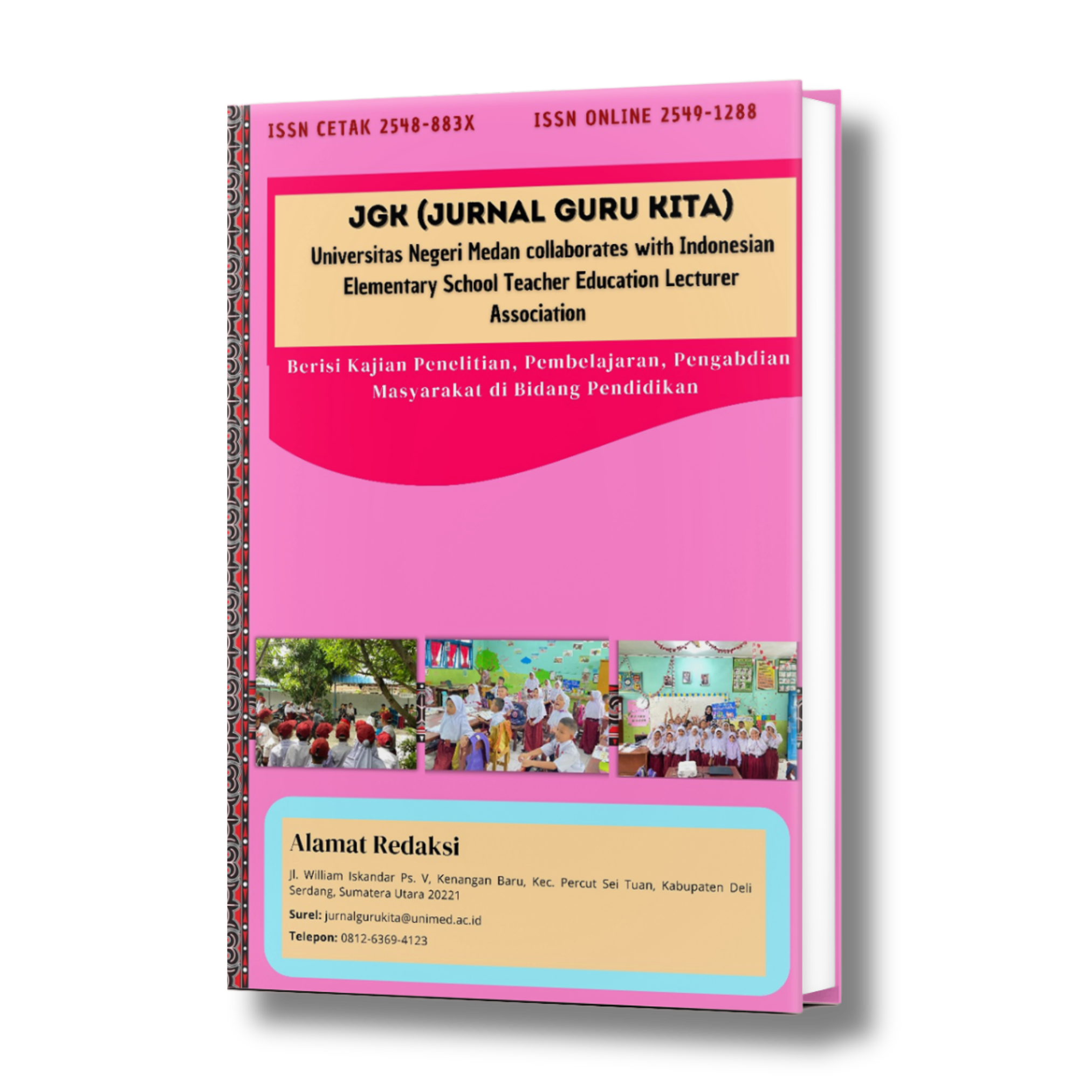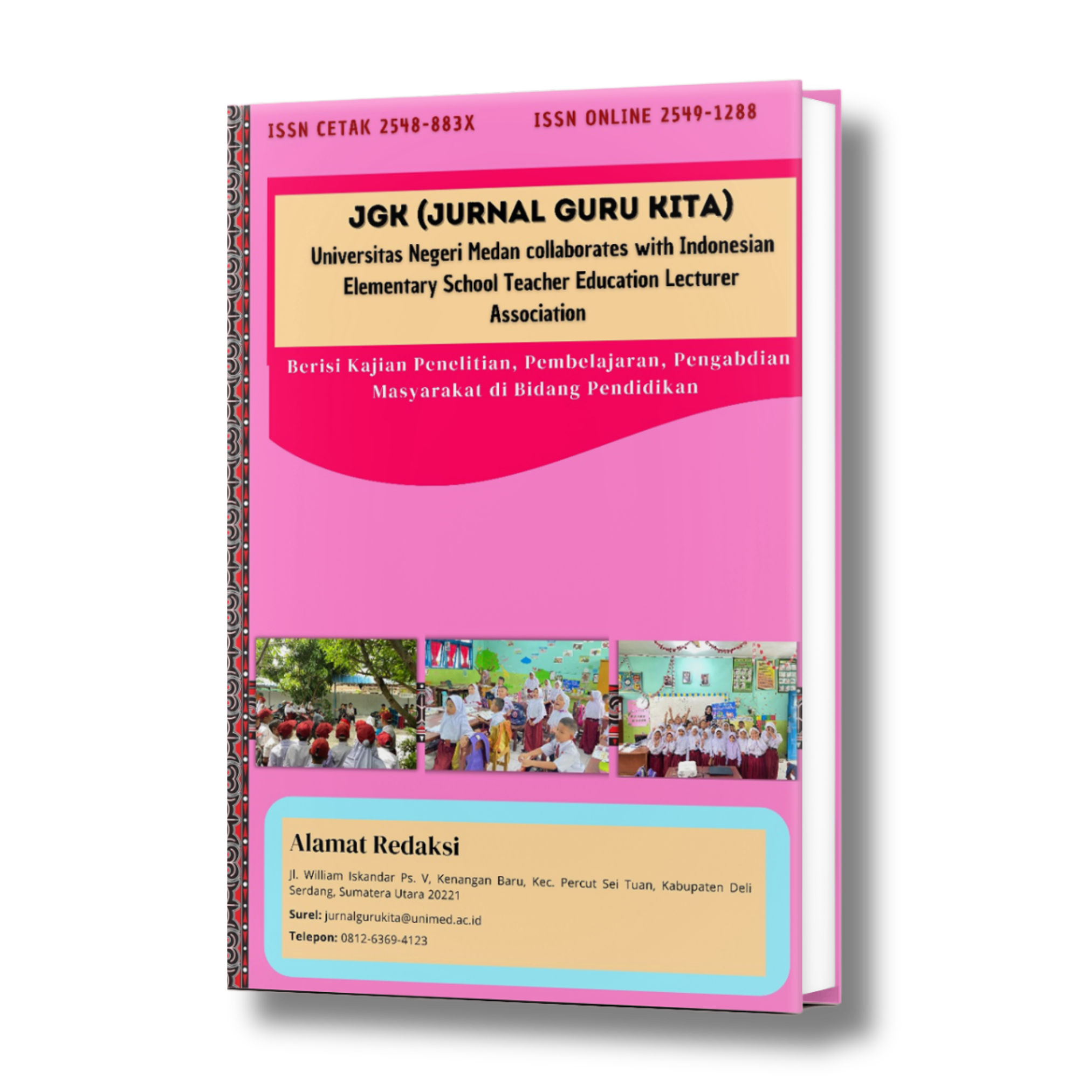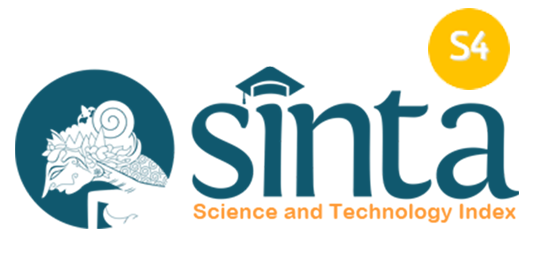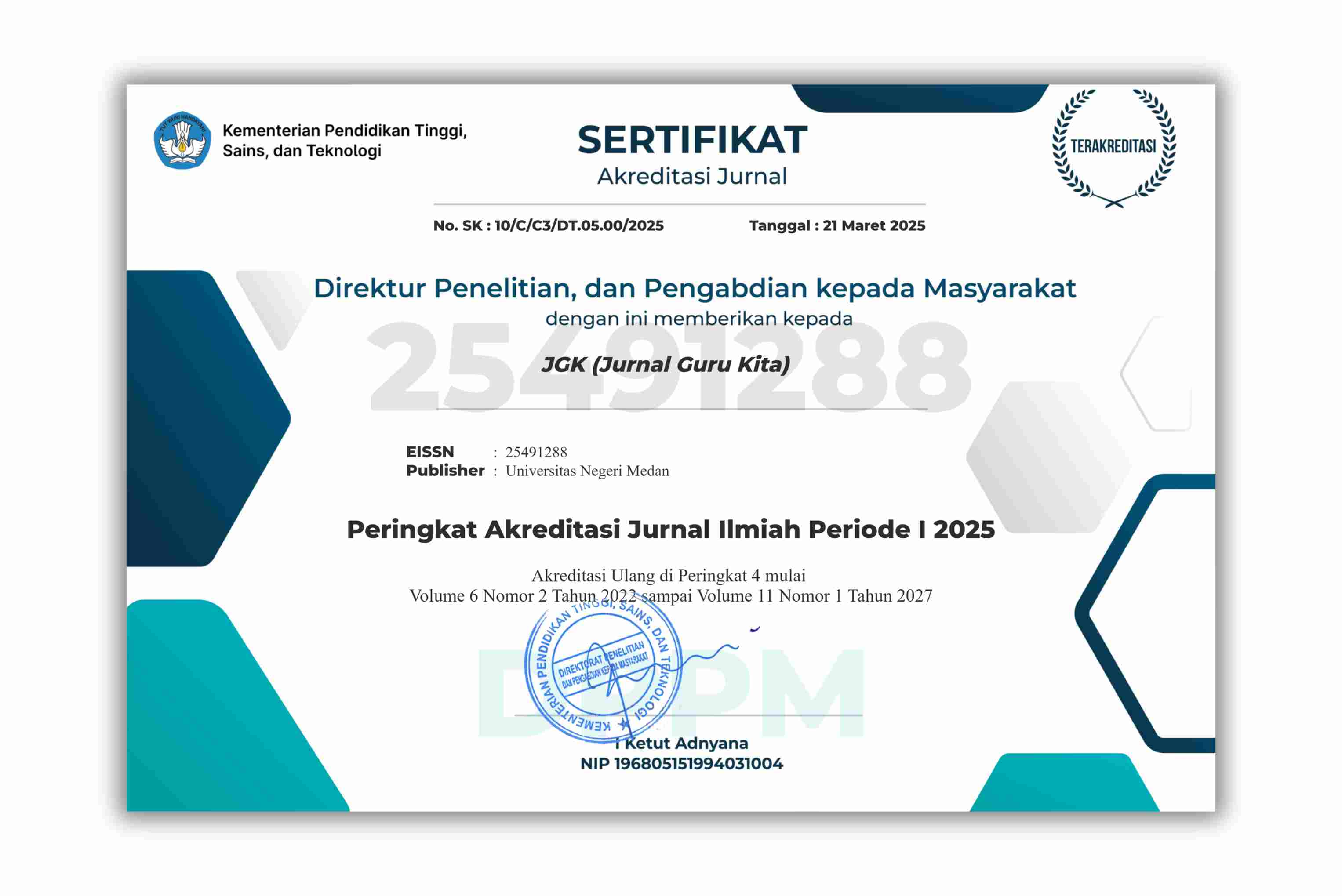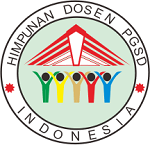Peningkatan Minat dan Prestasi Belajar IPAS Model SAVI dengan Media Flash Card
DOI:
https://doi.org/10.24114/jgk.v9i4.65444Keywords:
SAVI, Flash Card, Minat Belajar, Prestasi BelajarAbstract
Penelitian ini bertujuan meningkatkan minat dan prestasi belajar siswa kelas V SDN Tembongraja 02 pada mata pelajaran IPAS melalui model pembelajaran SAVI (Somatic, Auditory, Visual, Intellectual) yang dipadukan dengan media Flash Card. Metode yang digunakan adalah Penelitian Tindakan Kelas (PTK) model Kemmis dan McTaggart, dilaksanakan dalam dua siklus yang mencakup tahap perencanaan, tindakan, observasi, dan refleksi. Teknik pengumpulan data meliputi tes prestasi belajar, observasi, dokumentasi, dan angket minat belajar. Hasil penelitian menunjukkan bahwa penerapan model SAVI dengan media Flash Card meningkatkan keterlibatan siswa dalam pembelajaran dan berdampak positif pada capaian belajar. Pada Siklus I, tingkat keaktifan siswa mencapai 94,7%, dan meningkat menjadi 100% di Siklus II. Hasil evaluasi juga menunjukkan adanya peningkatan prestasi belajar di setiap siklus. Perpaduan model SAVI dan media Flash Card mampu menciptakan pembelajaran yang interaktif dan menyenangkan. Penelitian ini merekomendasikan pendekatan tersebut sebagai strategi inovatif untuk meningkatkan kualitas pembelajaran IPAS di tingkat sekolah dasar.References
Alsadoon, E., Alkhawajah, A., & Suhaim, A. Bin. (2022). Effects of a gamified learning environment on students’ achievement, motivations, and satisfaction. Heliyon, 8(8), e10249. https://doi.org/10.1016/j.heliyon.2022.e10249
Arikunto. (2017). Pengembangan Instrumen Penelitian dan Penilaian Program. Pustaka Belajar.
Arikunto, S. (2021). Penelitian tindakan kelas: Edisi revisi. Bumi Aksara.
Ashari, M. K., Rohmah, A. N., & Yudi, U. (2023). Joyful Learning with App-Based Interactive Quizzes in Senior High Schools in the Digital Era. Jurnal Cendekia Media Komunikasi Penelitian Dan Pengembangan Pendidikan Islam, 15(02), 210–228. https://doi.org/10.37850/cendekia.v15i02.528
Cayubit, R. F. O. (2022). Why learning environment matters? An analysis on how the learning environment influences the academic motivation, learning strategies and engagement of college students. Learning Environments Research, 25(2), 581–599. https://doi.org/10.1007/s10984-021-09382-x
Dewaele, J.-M., & Li, C. (2021). Teacher enthusiasm and students’ social-behavioral learning engagement: The mediating role of student enjoyment and boredom in Chinese EFL classes. Language Teaching Research, 25(6), 922–945. https://doi.org/10.1177/13621688211014538
El Kharki, K., Berrada, K., & Burgos, D. (2021). Design and Implementation of a Virtual Laboratory for Physics Subjects in Moroccan Universities. Sustainability, 13(7), 3711. https://doi.org/10.3390/su13073711
Febrina, V., & Setiawan, D. (2024). Analysis of the Use of Learning Media on the Learning Interest of Learning Science Students and Environmental Themes. Jurnal Penelitian Pendidikan IPA, 10(8), 5702–5709. https://doi.org/10.29303/jppipa.v10i8.7497
Handini*, R., Ariyanti, N. A., & Kurniawan, F. (2023). Students’ Problem Solving Skill on the Ecosystem Materials Through Somatic, Auditotry, Visual and Intellectual Model. Jurnal Pendidikan Sains Indonesia, 11(2), 333–344. https://doi.org/10.24815/jpsi.v11i2.28546
Hsia, L.-H., Lin, Y.-N., Lin, C., & Hwang, G.-J. (2025). Prompting somatic practice performance with AI-facilitated peer-assisted learning: A self-determination theory perspective. Education and Information Technologies. https://doi.org/10.1007/s10639-025-13681-8
Jakubowicz, S. (2025). Embodied Game Interactions: Somatosensation, Self-Identification, and the Potential of Alternative Game Controllers (pp. 477–484). https://doi.org/10.1007/978-3-031-74138-8_41
Khairani Wijaya, A. M., Jaya, A., & Prasrihamni, M. (2023). DEVELOPING THE TEACHING MATERIALS FOR WRITING SHORT STORIES BASED ON THE SAVI APPROACH (SOMATIC, AUDITORY, VISUALIZATION, INTELLECTUAL). Esteem Journal of English Education Study Programme, 6(2), 361–369. https://doi.org/10.31851/esteem.v6i2.12326
Khairunnisa, K., Abdullah, A., Khairil, K., & Rahmatan, H. (2022). The Influence of Problem Based Learning Models combined with Flashcard Media on Creative Thinking Skills of Students. Jurnal Penelitian Pendidikan IPA, 8(1), 247–251. https://doi.org/10.29303/jppipa.v8i1.1154
Khodadad, D. (2023). Creating a Supportive and Effective Learning Environment for Engineering Students. International Journal of Engineering Pedagogy (IJEP), 13(8), 33–50. https://doi.org/10.3991/ijep.v13i8.41755
Kusrini, I., Rintayati, P., & Salimi, M. (2025). THE EFFECT OF THE SAVI LEARNING MODEL ON THE COGNITIVE LEARNING OUTCOME OF STUDENTS. JURNAL EDUSCIENCE, 12(4), 1059–1071. https://doi.org/10.36987/jes.v12i4.7140
Kusumawati, N. (2018). PENINGKATAN HASIL BELAJAR SISWA KELAS V DENGAN MODEL PEMBELAJARAN SAVI PADA MATA PELAJARAN IPA DI SDN MANGKUJAYAN I KABUPATEN PONOROGO. JURNAL PENDIDIKAN DASAR NUSANTARA, 3(2), 217. https://doi.org/10.29407/jpdn.v3i2.11789
Kwangmuang, P., Jarutkamolpong, S., Sangboonraung, W., & Daungtod, S. (2021). The development of learning innovation to enhance higher order thinking skills for students in Thailand junior high schools. Heliyon, 7(6), e07309. https://doi.org/10.1016/j.heliyon.2021.e07309
Laili, I. N., Gumala, Y., Awiria, A., Syaodih, E., & Samsudin, A. (2023). Using Somatic, Auditory, Visualization, Intellectually (SAVI) Learning Model On Primary School To Enhance Science Learning Outcomes. Briliant: Jurnal Riset Dan Konseptual, 8(2), 319. https://doi.org/10.28926/briliant.v8i2.1273
Li, Y., Zhang, M., & Chen, C. (2022). A Deep-Learning intelligent system incorporating data augmentation for Short-Term voltage stability assessment of power systems. Applied Energy, 308, 118347. https://doi.org/10.1016/j.apenergy.2021.118347
Liu, M., & Yu, D. (2023). Towards intelligent E-learning systems. Education and Information Technologies, 28(7), 7845–7876. https://doi.org/10.1007/s10639-022-11479-6
Lu, G., Xie, K., & Liu, Q. (2022). What influences student situational engagement in smart classrooms: Perception of the learning environment and students’ motivation. British Journal of Educational Technology, 53(6), 1665–1687. https://doi.org/10.1111/bjet.13204
Maharani Zaniyati Hazmi, & Rohmani. (2025). Analysis of the Effectiveness of Using SAVI Model in Science Learning at Elementary School : Literature Review. Indonesian Journal of Educational Research and Review, 8(1), 223–234. https://doi.org/10.23887/ijerr.v8i1.85349
Mokmin, N. A. M., & Rassy, R. P. (2024). Review of the trends in the use of augmented reality technology for students with disabilities when learning physical education. Education and Information Technologies, 29(2), 1251–1277. https://doi.org/10.1007/s10639-022-11550-2
Mukaffa, Z., Chasanah, U., & Ahmala, M. (2023). Breaking the Barriers: Flash Card Media’s Role in Enhanching Literacy for Students with Special Needs. AL-ISHLAH: Jurnal Pendidikan, 15(3). https://doi.org/10.35445/alishlah.v15i3.2446
Nur Azmi Alwi, & Desi Aulia. (2023). Digital Flash Card Media for Early Reading Learning in Elementary Schools. Jurnal Ilmiah Sekolah Dasar, 7(1), 8–17. https://doi.org/10.23887/jisd.v7i1.56995
Nuradhisti, S. A., & Prasetyanigtyas, F. D. (2025). Development of Mystery Box Learning Media to Improve Elementary School Students’ Learning Outcomes. Jurnal Penelitian Pendidikan IPA, 11(3), 907–916. https://doi.org/10.29303/jppipa.v11i3.10801
Oh, J.-E., Chan, Y. K., Kong, A., & Ma, H. (2022). Animation Students’ Engagement and Motivation through Peer Teaching: Online Flipped Classroom Approach. Archives of Design Research, 35(1), 7–23. https://doi.org/10.15187/adr.2022.02.35.1.7
Oktradiksa, A., Suryawan, A., Hendradi, P., Budiningsih, A., & Wiludjeng, I. (2023). The application of exploratory factor analysis (EFA) in savi training model for science lessons using teaching tools based on contextual learning. 020031. https://doi.org/10.1063/5.0125780
Onu, P., Pradhan, A., & Mbohwa, C. (2024). Potential to use metaverse for future teaching and learning. Education and Information Technologies, 29(7), 8893–8924. https://doi.org/10.1007/s10639-023-12167-9
Oryzanda, O., Saifudin, A., & Widiarini, W. (2022). Developing Flashcards Learning Media to Teach Grammar in Recount Texts for Tenth Grade. Jo-ELT (Journal of English Language Teaching) Fakultas Pendidikan Bahasa & Seni Prodi Pendidikan Bahasa Inggris IKIP, 9(2), 109. https://doi.org/10.33394/jo-elt.v9i2.6346
Paldy, P., YR, S., Baharuddin, M. R., & Yunus, R. Y. I. (2025). Creating Engaging Flashcard Materials for Young Learners: A Developmental Study on English Language Teaching in Primary Schools. Journal of Languages and Language Teaching, 13(1), 88. https://doi.org/10.33394/jollt.v13i1.13009
Putri, F. A. K., Sorohiti, M., & Ariebowo, T. (2024). Teaching English Using Flashcards to Improve Elementary School Students’ Vocabulary. Journal of Foreign Language Teaching and Learning, 8(2), 198–215. https://doi.org/10.18196/ftl.v8i2.21350
Putri, R. I., Suhartono, S., & Chamdani, M. (2021). Penggunaan Model Pembelajaran Somatic, Auditory, Visualization, Intellectualy (SAVI) dalam Peningkatan Hasil Belajar IPA tentang Organ Pencernaan Manusia Kelas V SD Negeri 3 Dorowati Tahun Ajaran 2020/2021. Kalam Cendekia: Jurnal Ilmiah Kependidikan, 9(2). https://doi.org/10.20961/jkc.v9i2.46906
Rabgay, T., & Kidman, G. (2023). Multiple iterations and messiness in the implementation of action research by Bhutanese secondary science teachers. Discover Education, 2(1), 49. https://doi.org/10.1007/s44217-023-00077-4
Raza, S. A., Qazi, W., & Yousufi, S. Q. (2021). The influence of psychological, motivational, and behavioral factors on university students’ achievements: the mediating effect of academic adjustment. Journal of Applied Research in Higher Education, 13(3), 849–870. https://doi.org/10.1108/JARHE-03-2020-0065
Retnowati, E., Usodo, B., & Chumdari, C. (2025). Study on the Effectiveness of the SAVI Model in Improving Problem-Solving Skills in Mathematics for Sixth Grade Students: A Focus on Independent Learning Aspects. Social, Humanities, and Educational Studies (SHES): Conference Series, 8(1), 448. https://doi.org/10.20961/shes.v8i1.98967
Rohmah, I. A., & Prayogo, M. S. (2024). Application of Discovery Learning with Flashcard Media to Increase Active Mathematics Learning Madrasah Ibtidaiyah Students. EDUCARE: Journal of Primary Education, 5(1), 1–10. https://doi.org/10.35719/educare.v5i1.116
Rusticus, S. A., Pashootan, T., & Mah, A. (2023a). What are the key elements of a positive learning environment? Perspectives from students and faculty. Learning Environments Research, 26(1), 161–175. https://doi.org/10.1007/s10984-022-09410-4
Rusticus, S. A., Pashootan, T., & Mah, A. (2023b). What are the key elements of a positive learning environment? Perspectives from students and faculty. Learning Environments Research, 26(1), 161–175. https://doi.org/10.1007/s10984-022-09410-4
Saputra, N. (2021). Penelitian tindakan kelas. Yayasan Penerbit Muhammad Zaini.
Sariakin, S., Yeni, M., Usman, M. Bin, Mare, A. S., Munzir, M., & Saleh, M. (2025). Fostering a productive educational environment: the roles of leadership, management practices, and teacher motivation. Frontiers in Education, 10. https://doi.org/10.3389/feduc.2025.1499064
Shermukhammadov, B. (2022). Creativity of a Teacher in an Innovative Educational Environment. Journal of Higher Education Theory and Practice, 22(12). https://doi.org/10.33423/jhetp.v22i12.5468
Silsilatul Mutawar Ridho, Tri Wisudawatiningsih, E., & Zahrotul Mufidah, N. (2023). Model Pembelajaran SAVI dalam Meningkatkan Hasil Belajar IPA Siswa MI Nurul Islam Alaspandan. EL Bidayah: Journal of Islamic Elementary Education, 5(1), 16–29. https://doi.org/10.33367/jiee.v5i1.3522
Sofi-Karim, M., Bali, A. O., & Rached, K. (2023). Online education via media platforms and applications as an innovative teaching method. Education and Information Technologies, 28(1), 507–523. https://doi.org/10.1007/s10639-022-11188-0
Sudrajat, A., Salsabila, F. G., & Marini, A. (2023). Digital-Based Flash Card to Increase Social Studies Learning Outcomes for Elementary School Students in The Fourth Grade. Journal of Education Technology, 7(2), 235–246. https://doi.org/10.23887/jet.v7i2.63327
Sutarna, N. (2018). PENGARUH MODEL PEMBELAJARAN SAVI (SOMATIC AUDITORY VISUAL INTELLECTUALY) TERHADAP HASIL BELAJAR SISWA KELAS IV SEKOLAH DASAR. Profesi Pendidikan Dasar, 1(2), 119. https://doi.org/10.23917/ppd.v1i2.6068
Syifa Mutiara Puradireja. (2022). The Effectiveness of Flashcard Media and Letter Learning Applications to Help Dyslexic Children’s Reading Ability in Elementary School. Child Education Journal, 4(1), 61–78. https://doi.org/10.33086/cej.v4i1.2834
Tiyas, D., & Fatimah, M. (2019). Keefektifan model savi terhadap minat dan hasil belajar ipa sdn lawatan 01 kabupaten tegal. Indonesian Journal of Conservation, 8(1).
Viantorus, V. A. V., Wibowo, S. E., & Firdaus, F. M. (2024). Enhancing Fourth-Grade Elementary Students Mathematical Reasoning Skills Through the SAVI Model. Jurnal Pendidikan Progresif, 14(3), 2076–2087. https://doi.org/10.23960/jpp.v14.i3.2024141
Xodabande, I., Iravi, Y., Mansouri, B., & Matinparsa, H. (2022). Teaching Academic Words With Digital Flashcards: Investigating the Effectiveness of Mobile-Assisted Vocabulary Learning for University Students. Frontiers in Psychology, 13. https://doi.org/10.3389/fpsyg.2022.893821
Downloads
Published
How to Cite
Issue
Section
License
Copyright (c) 2025 Reza Rosdiana, Agung Nugroho

This work is licensed under a Creative Commons Attribution-ShareAlike 4.0 International License.
Authors published with the JGK (Jurnal Guru Kita) agree to the following terms:
- Authors retain copyright and grant the journal the right of first publication with the work simultaneously licensed under a Creative Commons Attribution License (CC BY-SA 4.0) that allows others to share the work with an acknowledgment of the work's authorship and initial publication in this journal.
- Authors are able to enter into separate, additional contractual arrangements for the non-exclusive distribution of the journal's published version of the work (e.g., post it to an institutional repository or publish it in a book), with an acknowledgment of its initial publication in this journal.
- Authors are permitted and encouraged to post their work online (e.g., in institutional repositories or on their website) prior to and during the submission process, as it can lead to productive exchanges, as well as earlier and greater citation of published work. (See The Effect of Open Access)

